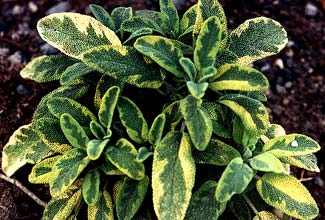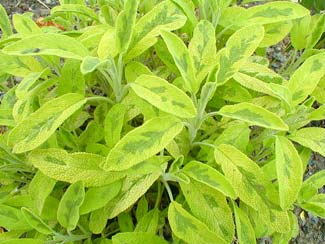
'Icterina'
Golden Variegated Sage
"Of every star that heaven doth shew,
And every herb that sips the dew."
-John Milton
(1608-1674)
(1608-1674)
We've two cultivars of Salvia officinalis growing in a sun-garden by the road. Planted beside the Tricolored Sage are two smaller clumps of 'Icterina,' or Golden Variegated Sage. Though both varieties are growing together in identical conditions, 'Icterina' has been spreading at about one-third the rate of 'Tricolor,' though they were originally planted at the same size at the same time scant feet from one another.
All the fancier cultivars of S. officinalis are restrained in the garden compared to the species per se, which can go a little wild; & 'Icterina' is more restrained than most. While none of the varieties can be regarded as tender, the ones which are slowest growing, which are predominantly varieties with golden, chartreuse, or variegated leaves, are somewhat more at risk of dying during protracted wet winters. This is especially true of 'Aurea,' 'Icterina,' & the Icterina sport 'Kew Gold.' Planting on raised hills or stone ledges will help get them through winters.
 The first photograph shows 'Icterina' in September. It lasts through the winter as an evergreen clump, but by late winter or early spring it will require all the winter-injured bits to be removed. It's a little slow to recover, but by May it is entirely new & fresh.The second photo shows it in June.
The first photograph shows 'Icterina' in September. It lasts through the winter as an evergreen clump, but by late winter or early spring it will require all the winter-injured bits to be removed. It's a little slow to recover, but by May it is entirely new & fresh.The second photo shows it in June.Though such colorful cultivars are generally grown for their decorative value, they are also as edible as any less colorful form. As a seasoning, no packaged sage or extract will ever out-do fresh cut leaves from the garden. Meat eaters can bruise & crumple a whole leaf & use it almost like a washrag to wipe fish or pork or red meat on all sides before frying or baking, or mixed with stuffing for turkey.
Us vegetarians can chop it fine & mix a little with scrambled eggs or quiches, or mix with grated cheese to cover baked lasagna & other ovened casaroles. A bit of it can even be included with a mixed leaf salad; just a couple of tender young 'Tricolor' & 'Icterina' leaves can add a lot of color to the salad.
When harvesting leaves, or otherwise pruning, always leave the stem behind. If it is trimmed back to the woody or semi-woody base it will not resprout, but trimmed above the ground so as to leave the stems, it will soon generate fresh leaves. A slow grower like 'Icterina' can only spare the occasional leaf; other varieties with swift growth can be harvested at intervals throughout the year, taking up to 25% of the leaves, but not more or the clump will become stressed.
Steeped as a tea it is best mixed with mint, beebalm, or lemon balm likewise taken fresh from the garden; or your boring camomile tea or commonplace Earl Grey can be considerably perked up with half a big leaf of fresh sage added to a steeping pot. A couple of leaves should also be tossed in a blender with yogurt, banana or pineapple, or whatever else usually goes into your favorite fruit smoothy.
Though dried sage is not the equal of fresh, if you do want to dry & crumble some leaves for winter use, select mature but not overaged leaves, which are richest in the essential oils, as these will make the most flavorful dried spice. Commercially, sage's steam-extracted essential oils are used not only in saugages but as a flavorful antioxidant in many processed pickles, cheeses, & vegetables. It is also used in natural insect repellants & in cosmetics. A most useful plant!